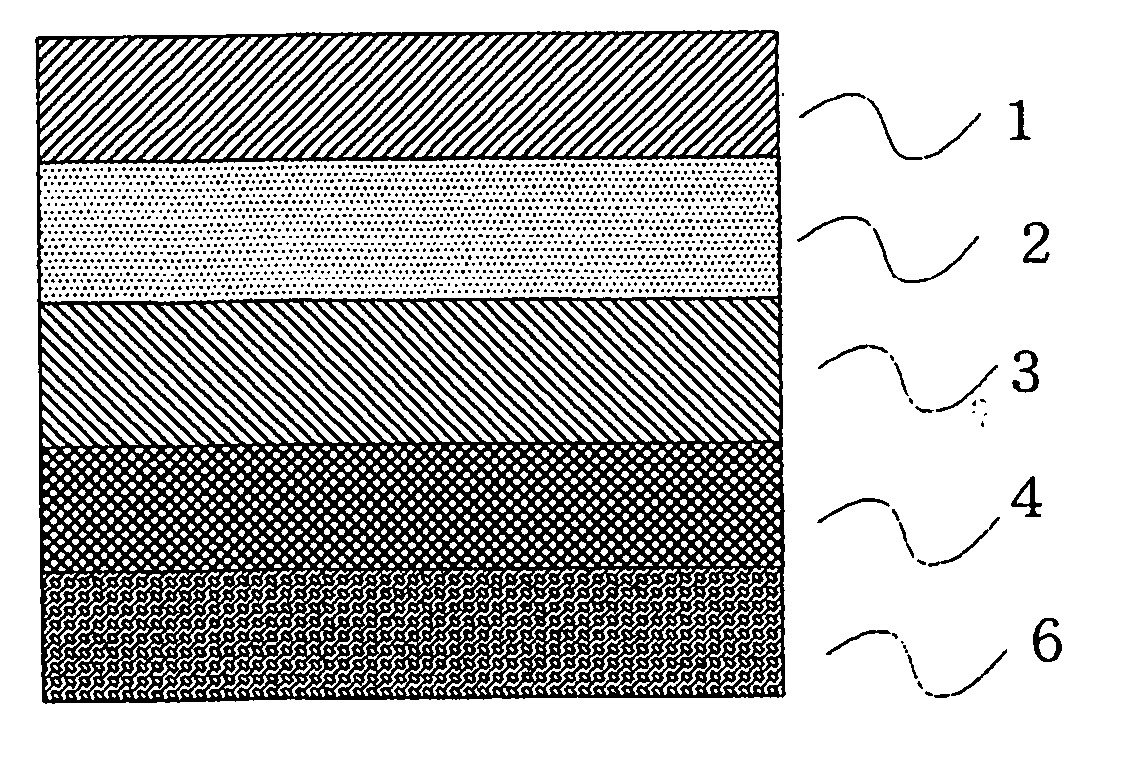Volume hologram transfer foil, and volume hologram multilayer structure
a multi-layer structure and transfer foil technology, applied in the field of volume hologram transfer foil and volume hologram multi-layer structure, can solve the problems of difficult selection of heat sealing agents showing satisfactory adhesion, difficult to fake, and difficult to achieve outside appearances that are difficult to achieve by other imaging means
- Summary
- Abstract
- Description
- Claims
- Application Information
AI Technical Summary
Benefits of technology
Problems solved by technology
Method used
Image
Examples
example 1
First Multilayer Structure Having a Volume Hologram-forming Material Layer
[0119] A volume hologram-forming material composed of 40 parts of the composition, mentioned just below, and 60 parts by mass of a mixed solvent consisting of methyl ethyl ketone / methanol=1 / 1 (by mass) was coated on a 50 μm-thick PET film (Lumilar T60 made by Toray Industries Inc.) at a dry thickness of 20 μm by means of gravure coating.
Binder resin {methyl methacrylate / glycidyl30parts by massmethacrylate copolymer having a copolymerizationratio (by mass) of 90 / 10 and a weight-averagemolecular weight of 50,000}:Bis(4-acryloxydiethoxyphenyl)methane:30parts by mass1,6-hexanediol diglycidyl ether:30parts by massPhotoradical polymerization initiator (also acting as4parts by massphotocation polymerization initiator)(diphenyliodonium hexafluoroantimonate)Sensitizer (3,9-diethyl-3′-carboxymethyl-2,2′-1part by massthiacarbocyanine iodine salt):Fine particles (Fluon L170J made by Asahi Glass5parts by massCo., Ltd. a...
example 2
[0124] The inventive volume hologram transfer foil was obtained as in Example 1 with the exception that the material having the following composition was used for the coating of the heat seal layer.
Polyester resin (Vylon BX1001 made by30parts by massToyobo Ltd. and having a Tg of −18° C. and anumber-average molecular weight of 28,678)Solvent (methyl ethyl ketone / toluene = 1 / 1 by mass)70parts by mass
example 3
[0125] The inventive volume hologram transfer foil was obtained as in Example 1 with the exception that the material having the following composition was used for the coating of the heat seal layer.
Polyester resin (Vylon UR8700 made by30parts by massToyobo Ltd. and having a Tg of −22° C. and anumber-average molecular weight of 29,208)Solvent (methyl ethyl ketone / toluene = 1 / 1 by mass)70parts by mass
PUM
| Property | Measurement | Unit |
|---|---|---|
| glass transition temperature | aaaaa | aaaaa |
| melting point | aaaaa | aaaaa |
| thickness | aaaaa | aaaaa |
Abstract
Description
Claims
Application Information
 Login to View More
Login to View More - R&D
- Intellectual Property
- Life Sciences
- Materials
- Tech Scout
- Unparalleled Data Quality
- Higher Quality Content
- 60% Fewer Hallucinations
Browse by: Latest US Patents, China's latest patents, Technical Efficacy Thesaurus, Application Domain, Technology Topic, Popular Technical Reports.
© 2025 PatSnap. All rights reserved.Legal|Privacy policy|Modern Slavery Act Transparency Statement|Sitemap|About US| Contact US: help@patsnap.com



